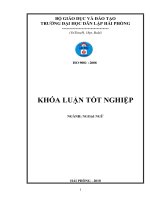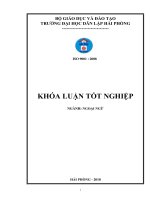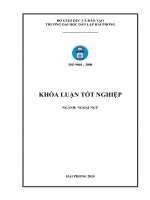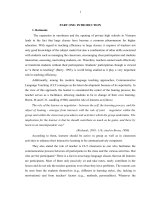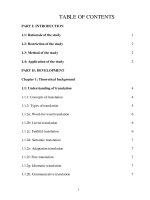Study on advanced modulation formats in coherent optical communication systems
Bạn đang xem bản rút gọn của tài liệu. Xem và tải ngay bản đầy đủ của tài liệu tại đây (1.51 MB, 166 trang )
STUDY ON ADVANCED MODULATION FORMATS IN
COHERENT OPTICAL COMMUNICATION SYSTEMS
ZHANG HONGYU
NATIONAL UNIVERSITY OF SINGAPORE
2012
STUDY ON ADVANCED MODULATION FORMATS IN
COHERENT OPTICAL COMMUNICATION SYSTEMS
ZHANG HONGYU
(B.Sc., Dalian University of Technology, China)
A THESIS SUBMITTED
FOR THE DEGREE OF DOCTOR OF PHILOSOPHY
DEPARTMENT OF ELECTRICAL AND COMPUTER ENGINEERING
NATIONAL UNIVERSITY OF SINGAPORE
2012
Study on Advanced Modulation Formats in Coherent Optical Communication Systems
- I -
Acknowledgement
First and Foremost, I would like to express my deepest gratitude to my supervisors Dr. Yu
Changyuan and Prof. Kam Pooi-Yuen for their invaluable guidance and kind support
throughout my Ph.D study. From them, I learnt not only knowledge, research skills and
experience, but also the right attitudes and wisdom towards research and life.
I would like to thank fellow researchers Dr. Chen Jian, Zhang Shaoliang, Zhang
Banghong, Cao Shengjiao, Xu Zhuoran, Wu Mingwei, Da Bin, Gao Zhi, and many others for
their help in my research.
I would like to thank lab officer Mr. Goh Thiam Pheng for providing a perfect working
environment for me.
I would like to thank my closest friends for their emotional support.
Last but not least, I would like to express my sincere appreciation to my parents and other
family members for their love and encouragement.
Study on Advanced Modulation Formats in Coherent Optical Communication Systems
- II -
Contents
Acknowledgement……………………………………………………I
Contents…………………………………………………………… II
Abstract…………………………………………………………… V
List of Figures…………………………………………………… VII
List of Tables………………………………………………………XII
List of Abbreviations…………………………………………….XIII
1 Introduction………………………………………………………1
1.1 Background…………………………………………………… 1
1.2 Literature Review………… ………………………………… 5
1.2.1 Coherent Detection Systems……………………………… 5
1.2.2 Polarization Demultiplexing……………………………… 9
1.2.3 Frequency Offset Estimation……………………………….10
1.2.4 Phase Estimation………………………………………… 11
1.2.4.1
Viterbi &Viterbi Mth-power Phase Estimation…………… 11
1.2.4.2
Decision-Aided Maximum Likelihood Phase Estimation… 13
1.3 Objectives and Contribution of the Study…………………… 18
1.4 Organization of the Thesis…………………………………….19
2 Performance Analysis of 4-Point Modulation Formats………21
2.1 BER Derivation of BPSK…………………………………… 22
Study on Advanced Modulation Formats in Coherent Optical Communication Systems
- III -
2.1.1 BER of BPSK in AWGN Channel…………………………22
2.1.2 BER of BPSK with a Phase Estimation Error…………… 26
2.1.3 Approximate BER of BPSK……………………………… 28
2.2 Performance Analysis of QPSK……………………………….31
2.2.1 Conditional SER and BER of QPSK………………………31
2.2.2 Approximate SER and BER of QPSK…………………… 35
2.3 Performance Analysis of 4-PAM…………………………… 36
2.3.1 Conditional SER and BER of 4-PAM…………………… 36
2.3.2 Approximate SER and BER of 4-PAM……………………40
2.4 Performance Analysis of (1, 3)……………………………… 41
2.4.1 Conditional SER and BER of (1, 3)……………………… 41
2.4.2 Approximate SER and BER of (1, 3)………………………45
2.5 Results and Discussions……………………………………….45
2.6 Cross-over SNR between QPSK and (1, 3)………………… 50
2.7 Conclusions……………………………………………………54
3 Performance Analysis of 8-Point Modulation Formats………55
3.1 Performance Analysis of 8-PSK………………………………56
3.2 Performance Analysis of Rectangular 8-QAM……………… 57
3.2.1 Conditional BER of Rectangular 8-QAM……………… 58
3.2.2 Approximate BER of
Rectangular 8-QAM………………66
3.3 Performance Analysis of 8-point Star QAM………………… 68
3.3.1 Analysis of 8-star QAM………………………………….68
3.3.1.1 BER of 8-star QAM………………………………………….69
3.3.1.2 Ring Ratio Optimization…………………………………… 73
3.3.2 Analysis of Rotated 8-star QAM…………………………75
Study on Advanced Modulation Formats in Coherent Optical Communication Systems
- IV -
3.3.2.1 BER of Rotated 8-star QAM…………………………………75
3.3.2.2 Ring Ratio Optimization…………………………………… 80
3.4 Performance Analysis of Triangular 8-QAM…………………81
3.5 Results and Discussions……………………………………….85
3.6 Conclusions……………………………………………………95
4 Performance Analysis of Higher-order Modulation Formats 97
4.1 Analysis of 16-Star QAM…………………………………… 98
4.1.1 Introduction of 16-star QAM………………………………98
4.1.2 Craig’s Method…………………………………………… 99
4.1.3 Conditional BER of 16-star QAM……………………… 101
4.1.4 Results and Discussions………………………………… 104
4.2 Analysis of 64-QAM…………………………………………108
4.2.1 Conditional BER of 64-QAM…………………………….108
4.2.2 Results and Discussions………………………………… 110
4.3 Conclusions………………………………………………… 113
5 Experiments……………………………………………………114
5.1 Experimental Setup………………………………………… 114
5.2 Results and Discussions…………………………………… 118
5.3 Conclusions………………………………………………… 127
6 Conclusions and Future Work……………………………… 128
6.1 Conclusions………………………………………………… 128
6.2 Future Work………………………………………………….130
Appendix………………………………………………………… 132
References…………………………………………………………134
Publication List……………………………………………………148
Study on Advanced Modulation Formats in Coherent Optical Communication Systems
- V -
Abstract
Recently, advanced modulation formats with digital coherent detection have attracted
extensive attention in coherent optical communications, since they can achieve a high spectral
efficiency (SE). One major issue in coherent optical communication systems is to recover
carrier phase, which is perturbed by phase noise generated from the laser linewidths of both
the transmitter and local oscillator (LO). Digital-signal-processing (DSP) based phase
estimation (PE) algorithms, such as Mth power and Decision-aided (DA) maximum likelihood
(ML), are preferred at the receiver for carrier phase recovery. The PE algorithm has a residual
phase estimation error
which degrades the system performance.
This thesis systemically studies the performance of different advanced modulation
formats (4-point, 8-point, and higher-order) in the presence of laser phase noise and additive
white Gaussian noise (AWGN), and experimentally verifies our analysis and simulations in
the coherent optical B2B systems.
First of all, the conditional bit-error rates (BER) of different modulation formats are
derived in the presence of a random phase estimation error and AWGN. Through a series of
approximations, simple and accurate approximate BERs are obtained, which allow quick
estimations of the BER performance and laser linewidth (LLW) tolerance.
In addition, these approximate BERs can also lead to some initial results as follows:
Study on Advanced Modulation Formats in Coherent Optical Communication Systems
- VI -
(1) The cross-over signal-to-noise ratio (SNR) algorithm between QPSK and (1, 3), which
allows a quick and accurate estimation of the cross-over SNR point between QPSK and (1, 3)
under different phase estimation error variance;
(2) The ring ratio optimization algorithms of 8-star QAM and rotated 8-star QAM,
respectively. These algorithms can be used to quickly find out the optimum ring ratio under
different conditions, such as SNR/bit, LLW, and symbol rate;
(3) The reason why 8-star QAM has more phase noise tolerance than rotated 8-star QAM
is discussed based on the approximate BERs.
We also evaluate the BER performance and LLW tolerance for higher-order modulation
formats, such as 16-star QAM and 64-QAM. The optimum ring ratio and ring ratio fluctuation
penalty is numerically studied for 16-star QAM. Moreover, coherent optical B2B experiments
are conducted in this thesis to verify our analysis and simulations.
This study illustrates the procedure in detail how to carry out the analysis for advanced
modulation formats, and how to optimize the performance for two-dimensional constellations.
More importantly, the results in the thesis provide algorithms and comments which can be used
for the electrical engineers to choose the best modulation formats and optimum parameters of
each constellation under different conditions.
Study on Advanced Modulation Formats in Coherent Optical Communication Systems
- VII -
List of Figures
1.1 Block diagram of a coherent homodyne receiver……………………………………… 5
1.2 The structure of a butterfly FIR filter…………………………………………………….9
1.3 Mth-power processing circuit diagram………………………………………………….11
1.4 The block diagram of the DA ML PE method………………………………………… 14
1.5 Simulated BER performance of 20-Gb/s QPSK (10-Gsymbol/s) with Mth-power, DE
DA ML, and PA DA ML (linewidth per laser 100 kHz
)……………………… 17
1.6 Simulated BER performance of 30-Gb/s 8-PSK (10-Gsymbol/s) with Mth-power, DE
DA ML, and PA DA ML (linewidth per laser
100 kHz
)……………………… 17
2.1 Constellation map and decision boundary of BPSK…………………………………….22
2.2 Constellation map and decision boundary of BPSK with a phase estimation error
27
2.3 Comparison between exact numerical BER, MC simulation, and approximate BER when
222
110 rad
…………………………………………………………………… 31
2.4 Constellation map, decision boundaries and Gray code mapping of QPSK with a phase
estimation error
……………………………………………………………………….32
2.5 Constellation map, decision boundaries and Gray code mapping of 4-PAM with a phase
estimation error
……………………………………………………………………….37
Study on Advanced Modulation Formats in Coherent Optical Communication Systems
- VIII -
2.6 Illustration of MSB and LSB……………………………………………………………39
2.7 Constellation map, decision boundaries and bit mapping of (1, 3) with a phase estimation
error
………………………………………………………………………………… 42
2.8 The BERs from analysis and MC simulations in perfectly coherent case………………46
2.9 The BERs from analysis and MC simulations when
222
10 .rad
…………… 47
2.10 Comparison of BER approximations with exact results and MC simulations when
232
10 .rad
……………………………………………………………………… 47
2.11 Comparison of SER approximations with exact results and MC simulations when
232
10 .rad
……………………………………………………………………… 48
2.12 The SNR penalty @BER=10
-4
as a function of phase estimation error variance for
exact and approximate BER expressions…………………………………………………49
2.13 The cross-over SNR algorithm (2.49) between QPSK and (1, 3) and its
approximation (2.50) as a function of phase estimation error variance………………… 53
3.1 Constellation map, decision boundaries and Gray code mapping of 8-PSK with a phase
error .
…………………………………………………………………………………56
3.2 Constellation map, decision boundaries and Gray code bit mapping of rectangular
8-QAM……………………………………………………………………………………58
3.3 Illustration of how the triangular region CDE is formed……………………………… 61
3.4 Plot of the ignored term
4,
|
tri
PA
…………………………………………………65
3.5
The comparison of exact BER expression (3.13 and 3.20) and approximation (3.22) for
rectangular 8-QAM……………………………………………………………………….67
Study on Advanced Modulation Formats in Coherent Optical Communication Systems
- IX -
3.6 Constellation map, decision boundaries and Gray code mapping of 8-star QAM with a
phase error
.
……………………………………………………………………………69
3.7
Constellation maps and decision boundaries of rotated 8-star QAM with a phase
estimation error
.
…………………………………………………………………… 75
3.8
Constellation maps and decision boundaries of triangular 8-QAM with a phase
estimation error
.
…………………………………………………………………… 82
3.9
The BERs from analysis and MC simulations in perfectly coherent case………………86
3.10
The BERs from analysis and MC simulations when
232
810 .rad
……….87
3.11
Comparison between numerical BERs, MC simulations, and approximate BERs
when
5
110
s
T
with optimum memory length………………………………….87
3.12
The SNR/bit penalty as a function of linewidth per laser symbol duration product
(
s
T
) when BER=10
-4
from numerical integration and approximation in different
8-point modulation formats……………………………………………………………….89
3.13
Optimum ring ratio as a function of SNR/symbol phase estimation error variance
product for 8-star QAM………………………………………………………………… 91
3.14
BER as a function of ring ratio
from numerical integration given 15 dB
b
and
232
110 rad
for 8-star QAM and rotated 8-star QAM…………………… 92
3.15
SNR penalties due to ring ratio shift for 8-star QAM and rotated 8-star QAM…….92
4.1
Constellation map and decision boundaries of 16-star QAM with a phase estimation
error
………………………………………………………………………………….98
4.2
One signal point and one of its decision regions……………………………………… 99
Study on Advanced Modulation Formats in Coherent Optical Communication Systems
- X -
4.3 The BERs of 16-star QAM from analysis and MC simulations before and after
optimization when
232
110 rad
………………………………………………… 104
4.4
BER as a function of ring ratio
with different
2
105
4.5
Optimum ring ratio versus different linewidth per laser symbol duration product 106
4.6
SNR penalty due to ring ratio fluctuation 106
4.7
The SNR penalty as a function of linewidth per laser symbol duration product………107
4.8
Constellation map, decision boundaries, and Gray code mapping of 64-QAM with a
phase error
…………………………………………………………………………108
4.9
Details in the decision region of signal S
0
…………………………………………… 109
4.10
The BERs of 64-QAM and 16-PSK from analysis and MC simulations. (a)
24
110
rad
2
, (b)
24
610
rad
2
……………………………………………….110
4.11
The SNR penalty as a function of linewidth per laser symbol duration product
(
s
T
) when BER=
4
10
with optimum memory length…………………………… 111
5.1
Optical transmitter for NRZ and RZ QPSK……………………………………………115
5.2
Experimental setups for optical RZ 8-point star QAMs (8-star QAM and rotated 8-star
QAM).………………………………………………………………………………… 116
5.3
Experimental setup for optical RZ 8-PSK ………………… 117
5.4
BER performance comparison between experimental and theoretical BERs (2.23b) for
RZ QPSK……………………………………………………………………………… 118
5.5
Optimum ring ratios as a function of OSNR at LLW per laser of 100 kHz………… 120
5.6
Eye diagrams of signals at points a and b in figure 5.2 through direct detection. (a) RZ
QPSK (b) RZ 8-star QAM………………………………………………………………121
Study on Advanced Modulation Formats in Coherent Optical Communication Systems
- XI -
5.7 BER performance comparison of experimental RZ 8-star QAM signal and theoretical
formula (3.34) under different values of ring ratio at LLW=100 kHz per laser……… 121
5.8
BER performance comparison of experimental RZ rotated 8-star QAM signal and
theoretical formula (3.47) under different values of ring ratio at LLW=100 kHz per
laser …………………………………………………………………………………… 122
5.9
Constellation maps of (a) ring ratio=2.4 at OSNR=17 dB, (b) ring ratio=2.6 at OSNR=18
dB, and (c) ring ratio=2.0 at OSNR=19 dB…………………………………………… 123
5.10
BER performance comparison of experimental RZ 8-star QAM signal and theoretical
analysis under different LLWs………………………………………………………… 124
5.11
Recovered constellation map of 8-star QAM ………………………………….….125
5.12
BER performance comparison of experimental RZ rotated 8-star QAM signal and
theoretical analysis under different LLWs………………………………………………125
5.13
Recovered constellation map of rotated 8-star QAM…………………………… 126
5.14
BER performance comparison between experimental and theoretical BER (3.3) for
8-PSK……………………………………………………………………………………126
6.1
Constellation map and circular decision boundaries of (1, 3)…………………………131
Study on Advanced Modulation Formats in Coherent Optical Communication Systems
- XII -
List of Tables
3.1
The LLW tolerance comparison between 8-point modulation formats ……………… 89
4.1
Parameter details of 16-star QAM with a phase estimation error…………………… 101
4.2
Parameter details of 16-star QAM in perfectly coherent case…………………………103
4.3
Optimum ring ratio in different range of
s
T
105
Study on Advanced Modulation Formats in Coherent Optical Communication Systems
- XIII -
List of Abbreviations
ADC Analog-to-Digital Converter
AM Amplitude Modulator
ASK Amplitude-Shift Keying
AWG Arbitrary Waveform Generator
AWGN Additive White Gaussian Noise
B2B Back-to-Back
BER Bit-Error Rate
CD Chromatic Dispersion
CMA Constant Modulus Algorithm
DA ML Decision-Aided Maximum Likelihood
DD Differential Decoding
DE Differential Encoding
DFB Distributed Feedback
DPSK Differential Phase-Shift Keying
DSP Digital Signal Processing
ECL External Cavity Laser
EDFA Erbium-Doped Fiber Amplifier
Study on Advanced Modulation Formats in Coherent Optical Communication Systems
- XIV -
FEC Forward Error Control
FIR Finite Impulse Response
FOE Frequency Offset Estimation
IF Intermediate Frequency
IM/DD Intensity Modulation/Direct Detection
i.i.d independent identically distributed
IIR Infinite Impulse Response
IQ In-phase and Quadrature-phase
ISI Inter-symbol Interference
LD Laser Diode
LLW Laser Linewidth
LO Local Oscillator
LPF Low-Pass Filter
LSB Least Significant Bit
MB Middle Bit
MC Monte Carlo
MSB Most Significant Bit
MZM Mach-Zehnder Modulators
NRZ Non Return-to-Zero
OSNR Optical Signal-to-Noise Ratio
PA Pilot-Assisted
PAM Pulse Amplitude Modulation
PDF Probability Density Function
Study on Advanced Modulation Formats in Coherent Optical Communication Systems
- XV -
PE Phase Estimation
PLL Phase-Locked Loop
PM Phase Modulator
PMD Polarization Mode Dispersion
PPG Pulse Pattern Generator
PRBS Pseudo-Random Bit Sequences
PSK Phase-shift Keying
QAM Quadrature Amplitude Modulation
RP Reference Phasor
RZ Return-to-Zero
SE Spectral Efficiency
SER Symbol-Error Rate
SNR Signal-to-Noise Ratio
SPM Self-Phase Modulation
V&V Viterbi & Viterbi
WDM Wavelength Division Multiplexing
Study on Advanced Modulation Formats in Coherent Optical Communication Systems
–1–
Chapter 1
Introduction
1.1 Background
Optical communication systems refer to communication systems that use carriers of high
frequencies (~ 193.1 THz) and employ optical fibers for information transmission. Typically,
depending on the detection methods, optical communication systems can be classified into
two categories: direct detection and coherent detection. Intensity modulation with direct
detection (IM/DD) (Note that the acronym DD represents direct detection only if IM is in
front, otherwise, DD represents differential decoding) has been mainly used by researchers in
the early days of optical communications as it is a simple and cost effective scheme. However,
theoretically binary single-polarized IM/DD systems can only achieve a spectral efficiency
(SE) of 1 bit/s/Hz/polarization at most [1]. Besides, frequency and phase information cannot
be preserved when we use direct detection. As the increasing demand of high SE [2],
researchers began to employ some alternative modulation schemes, which transmit
information by modulating the phase of the optical carrier. Well-known modulation schemes
Study on Advanced Modulation Formats in Coherent Optical Communication Systems
–2–
are such as phase-shift keying (PSK) (which only modulate the phase of the optical carrier),
and quadrature amplitude modulation (QAM) (which simultaneously modulate both the
amplitude and phase of the optical carrier). By using this kind of modulation formats, SE can
be raised up to more than 1 bit/s/Hz/polarization [3].
Therefore, during the 1980s, coherent optical transmission techniques attracted extensive
attention. There are two motivations behind using coherent optical systems. First, compared
with IM/DD systems, the shot noise limited receiver sensitivity of coherent communication
techniques can be improved by up to 20 dB, thus greatly extending the unrepeated
transmission distance [1, 4]. Second, spectral efficiency of coherent systems can also be
improved by the use of advanced modulation formats. During those years, experimental
optical phase-lock loop (PLL) was used to lock the phase of the local oscillator (LO) laser to
that of the incoming signal. This scheme is referred to as homodyne detection. Homodyne
detection based on an optical PLL can directly demodulate the incoming optical signal to
baseband stage, but it was difficult and unstable to implement and operate at optical domain
[5, 6]. Hence, researchers turned to use heterodyne detection in order to simplify the design of
the receiver [7]. The heterodyne receivers firstly down-convert the incoming optical signal to
an intermediate frequency (IF) which is in microwave region, and then an electrical PLL is
employed to lock the phase of the intermediate frequency signal [8, 9]. But the IF must be
much higher than the signal bit rate. Due to the large laser linewidth (LLW) and PLL
feedback delay, most early works only focused on some simple modulation formats, such as
binary phase-shift keying (BPSK) and differential phase-shift keying (DPSK) [10, 11].
However, the R&D activities of coherent systems were interrupted for almost twenty
years owing to the invention of erbium-doped fiber amplifiers (EDFA) and
Study on Advanced Modulation Formats in Coherent Optical Communication Systems
–3–
wavelength-division multiplexing (WDM) techniques in the 1990s. Hence, the R&D interest
switched back to IM/DD systems from the year 1990 to around 2002. EDFA can be used to
increase the transmission distance [12], and WDM techniques can be employed to improve
the system capacity [13].
Since around 2002, coherent optical communication technologies, especially homodyne
detection systems, have been revived, due to the advent of high-speed analog-to-digital
converters (ADCs) [14-16]. Coherent detection schemes with the aid of the high-speed ADCs
are advantageous in that they provide the possibility to fully retrieve the amplitude and phase
information of an optical signal, and also to post-compensate for the chromatic dispersion
(CD), polarization-mode dispersion (PMD) and nonlinearity by using digital signal processing
(DSP) algorithms [17-24]. Because of many advantages of employing high-speed ADCs,
nowadays, the motivations in coherent communication systems are not only to improve the
receiver sensitivity, but also to improve the SE with the aid of high-order modulation formats
[25, 26]. Compared to the binary single-polarized IM/DD systems, whose SE is limited to 1
bit/s/Hz/polarization, advanced modulation formats with each symbol encoding
m
bits can
achieve an SE up to
m
bits/s/Hz/polarization. Moreover, coherent optical systems using
advanced modulation formats have higher tolerance to CD and PMD because they can reduce
symbol rate while keeping the same bit rate. The most commonly used multi-level modulation
formats in coherent communication systems are QPSK ( m = 2), 8-PSK, 8-QAM ( m = 3),
16-QAM (
m = 4) and 64-QAM ( m = 6). However, few studies have focused on analyzing the
performance of different advanced modulation formats in systems which include not only
AWGN noise but also linear phase noises.
Study on Advanced Modulation Formats in Coherent Optical Communication Systems
–4–
Generally, with the aids of ADCs and DSP, it is preferred to use homodyne detection
(phase-diversity coherent receivers) rather than heterodyne detection to down-convert the
optical signals near the baseband [27]. This scheme allows for a free-running LO laser,
therefore, optical PLL is not needed to lock the phase of LO laser to the carrier phase. Some
literatures also refer to this scheme as digital coherent receiver [26]. The structure and theory
of digital coherent receiver are mainly discussed in [28-30]. After the digital coherent receiver,
ADCs are used to sample the electrical signals. Then several DSP algorithms can be
employed in electrical domain to recover the original signals instead of using bulky and costly
optical components [31-35]. The DSP algorithms can be used to compensate linear and
nonlinear distortions. Firstly, CD and PMD are needed to be compensated by using finite
impulse response (FIR) or infinite impulse response (IIR) filters [36-40]. After the CD and
PMD compensation, inter-symbol interference (ISI) between two polarization states has to be
removed with the aid of a butterfly-like FIR filter with the blind constant modulus algorithm
(CMA) [41-45]. Before the signals are fed into the symbol detector, frequency offset
estimation (FOE) and phase estimation (PE) are also needed to be carried out to recover the
carrier phase. The conventional FOE based on Mth-power operations is studied in [46-48].
Decision feedback method is also used in FOE to enlarge the estimation range [49, 50]. A
feed-forward FOE based on Gardner timing recovery algorithm [51] is investigated in [52]
which can be implemented in a real-time receiver. Moreover, the conventional phase
estimation method is Viterbi & Viterbi (V&V) Mth-power method [53]. A modified
Mth-power PE method can also be applied to QAM systems, but suffers from system
performance degradation [54-56]. However, V&V Mth-power method requires phase
unwrapping to deal with phase ambiguity, and also requires many nonlinear computations [18,
Study on Advanced Modulation Formats in Coherent Optical Communication Systems
–5–
57]. Recently, researchers start to have interests on a computationally efficient decision-aided
(DA) maximum likelihood (ML) PE method [58, 59]. Adaptive version of this DA ML PE
method is also studied in [60, 61] which allows adaptively selection of the memory length.
In the following section, we will review in details the coherent detection systems and also
the DSP algorithms in the coherent receiver.
1.2 Literature Review
The first part of this section reviews the concept and implementation of coherent detection
systems. Several commonly-used DSP algorithms in the receiver are reviewed in the other
parts.
1.2.1 Coherent Detection Systems
Coherent optical communication systems started to attract extensive attention in the 1980s.
Since that time, the homodyne receiver is mainly used in coherent optical systems. Next we
will focus on discussing the concept and implementation of a homodyne receiver. The block
diagram of a single-polarization homodyne receiver is shown in figure 1.1.
90
PD1
PD2
PD3
PD4
LO
Figure 1.1 Block diagram of a coherent homodyne receiver.
Study on Advanced Modulation Formats in Coherent Optical Communication Systems
–6–
Basically, in any coherent detection systems, a local oscillator is employed as a phase
reference to beat with the received optical signal for the purpose of demodulation. Normally,
an optical phase-diversity homodyne receiver, which composes of four 3-dB couplers and one
90
phase shifter, is used to introduce a 90
hybrid. In such a receiver (see figure 1.1), the
received optical signal mixes with four states of LO reference signals in the 90
hybrid in
order to create the in-phase and quadrature-phase (IQ) components of the signal [28]. Then
the four different light signals are delivered into two pairs of balanced photodetectors. Note
that this coherent homodyne receiver can be applied to any advanced modulation formats
[26].
The transmitted optical signal model can be assumed as
exp .
sscss
E
tP jtjtjt
(1.1)
Here,
s
P is the power of the received signal, ( )
s
t
is the phase modulation of
corresponding signal,
c
is the angular carrier frequency of the signal, and
s
t
is the
phase noise from the transmitter laser. Similarly, the electromagnetic field of the LO output
can be written as
exp ,
LO LO LO LO
E
tP jtjt
(1.2)
where
L
O
P is the power of the LO,
L
O
is the angular carrier frequency of the LO output,
and
LO
t
is the phase noise from the LO laser.
The four inputs to the photodetectors can be represented as
1
exp 1
22
sLO
EE j n
, with n=1, 2, 3, and 4. Here, n denotes the order of the
Study on Advanced Modulation Formats in Coherent Optical Communication Systems
–7–
photodetectors as shown in figure 1.1. After the two balanced photodetectors, the IQ
components of the photocurrents can be expressed as
1
cos ( ) ,
s LO c LO s s LO shot
I
tRPP j tjtj t t n t
(1.3a)
2
sin ( ) ,
s LO c LO s s LO shot
Qt R PP j t j t j t t n t
(1.3b)
where
R
represents the responsitivity of the photodetector,
1shot
nt and
2shot
nt are
the shot noise from the photodetector [1]. Note that
1shot
nt and
2shot
nt are
independent. Here, in equation (1.3), when LO frequency coincides with the signal carrier
frequency (
cLO
), the receiver is a homodyne receiver; on the other hand, when
cLO
, the receiver is a heterodyne receiver. Homodyne receiver requires much less
bandwidth of the electrical low-pass filter (LPF) than the heterodyne receiver does [62], thus
makes it commonly used in coherent optical communication systems. Therefore, the received
base-band signal model in coherent homodyne receiver can be obtained by combining the IQ
components (1.3) together, and is given by
exp ( ) .
s LO s s LO shot
rt It jQt
R
PP j t j t t n t
(1.4)
It can be observed from equation (1.4) that the transmitted signals are rotated by a phase
noise
sLO
tt t
from both the transmitter and LO lasers. Hence,
sLO
tt t
is also called laser phase noise. After sampling the signals by ADCs,
the sampled waveform can be expressed as [6]
exp ( ) 2 .
ss
s
rk IkT jQkT
Ajkjkfjknk
(1.5)
Study on Advanced Modulation Formats in Coherent Optical Communication Systems
–8–
Here, k represents the kth sample over the time interval
,( 1)
s
s
kT k T ( 1
s
s
TR is the
symbol duration, and
s
R
is the symbol rate), ()rk is the received signal,
s
LO
ARPP is
the amplitude,
k
is the laser phase noise, and
nk is the shot noise. Note that the
frequency offset
f
between transmitter and LO lasers is considered here.
The laser phase noise stems from the LLW
of both the transmitter and LO. It can be
modeled as a random walk process (Wiener process), which is described as [6]
() ( ),
k
m
km
(1.6)
where
()m
are independent identically distributed (i.i.d) Gaussian random variables with
distribution
2
0,
p
N
. And the laser phase noise variance
2
p
in one symbol period
s
T
can be expressed as [63]
2
2(2 ) .
ps
T
(1.7)
Here,
2
means the sum of both LLWs of the transmitter and LO. It can be observed from
(1.6) that laser phase noise at current moment
k is an accumulation of all previous phase
noise from the beginning until
k . Therefore, the laser phase noise keeps rotating the phase of
the received signals, thus leading to performance degradation in coherent detection. Note that
laser phase noise is also named as linear phase noise. Besides linear phase noise, nonlinear
phase noise exists in long-haul transmission systems due to the self-phase modulation (SPM)
effect in the optical fiber [64-67]. Note that transmission is not taken into account in our
analysis and experiments. Furthermore, the shot noise
nk can be assumed as an additive
white Gaussian noise (AWGN) with mean 0 and variance
2
0
2
n
N
, where
0
N is the

